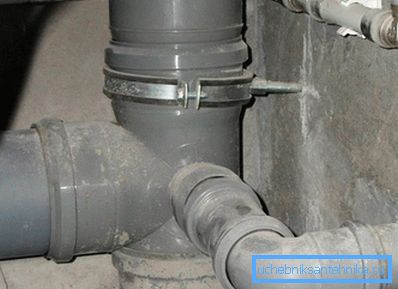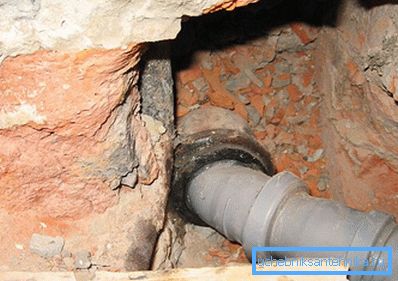Diameter of sewer pipe
At installation of the sanitary device there is a problem of its accession to system of the sewerage. To do this, you need to know what diameter pipe to pick up. In addition, it is desirable to navigate the situation on the market.
Variety of diameters

The diameter of the sewer pipe is largely dependent on the installation site. If you do not talk about the collectors, which collect all the wastewater from residential and industrial buildings, the diameter of the pipes inside the building is mostly 50, 110 mm. The diameters of external pipelines range from 110–600 mm.
Tip! Since the dictating factor in the choice of the diameter of the pipeline is the volume of wastewater, then during installation work, you should take into account how many plumbing products are installed and what is the throughput capacity of the pipes of the installed system.
- As a rule, the risers of the internal sewage system and the outlets to the external network have ~ 110 mm. Branches from sanitary devices, except for the toilet, are made of pipes with a diameter in the range of 32-50 mm.
- The external sewage of settlements is arranged in different diameters depending on the number of connection points along the direction of transportation of the drains being transported. From the private dwelling, as a rule, pipeline O 110 mm.
- From multi-apartment high-rise buildings, discharge into the external sewage system can be carried out with a Ø 160 mm pipeline
Pipes are known to have internal and external diameters. Previously, products made of cast iron or asbestos cement were used for the installation of sewage systems. In the technical literature and in the design, these pipes were indicated with an internal diameter, which is denoted Dвн. Now more often used pipes made of polymeric materials. For them, the outer diameter is already indicated with the designation DN.
In the design and installation of this need to particularly pay attention. Both diameter values play an important role depending on the work being done. When making calculations, it takes into account what the diameter of the pipe is in its inner part, while with direct mounting, the outer diameter comes to the first role. It is from him that they repel, when it is necessary to observe the normative distances to other communications, especially when laying pipelines below the surface of the earth.
Since pipes have a wide range, products with the same internal diameters can have a different external section and vice versa. It's all about the wall thickness. Pipes that are used in pressure sewers or are in the ground under the influence of large external loads, the wall thickness increases. Knowing the outer diameter of the tubular product and its wall thickness, it is possible to calculate the value of the internal cross section. For this, it is necessary to subtract two wall thicknesses from DN.
Diameters of sewer pipes from different materials

- Plastic sewer pipes in recent times are increasingly finding their application. Without any problems, they displace cast iron products that have been present on the market for more than a decade. Such products have comparative advantages, a diverse assortment and are easy to install. The range of plastic pipes offered for domestic sewage size in cross sections of 32, 50 and 110 mm. A large variety of shaped parts makes it easy to connect products. When joining pipes on the sockets, rubber gaskets are provided that prevent leaks from forming. The connection of products between themselves and fittings occurs due to not only the sockets, but also the soldering, which is carried out by special installations. Such pipes well pass drains. In addition, they are durable and serious accidents do not occur with their participation. External sewage networks are mounted from pipes with a diameter of 110 mm.
- Now PVC pipes are widely used. They are characterized by high wear resistance, long service life. In addition, the products have a good bandwidth. Practically they occupy a leading place today in the installation of sewer systems. In addition to the most popular sizes in cross sections of 32, 50 and 110 mm, the diameter of PVC pipes may be larger. When installing sewage pipelines outside buildings, products with a diameter in the range of 110–500 mm are used, and the walls can be up to 15 mm thick. Of course, pipes with such characteristics are laid for the construction of pipelines for main use.
- The good old cast-iron pipes, although they are becoming obsolete, are still used today. They are rarely used for indoor installation, but when laying external networks such products are still found. Modern cast iron pipes are made by casting. They resist corrosion well and have a coating on the inside that minimizes the flow of waste. The pipes are connected using sockets using cuffs or o-rings. Cast iron diameters are standard. The average diameters are determined by the dimensions in the section within 50–300 mm. When laying trunk lines, the diameters increase to 1200 mm.
Tip! To determine the diameter of the pipe, you need to look at the surface marking. The desired value is written at the end of the text in numbers.
Pipe diameters for plumbing fixtures

- Together with a washbasin or a sink, fittings are offered which can be connected to pipes O 40, 50 mm. On this basis, the most rational would be to divert from these sanitary devices O 50 mm. Such a pipe will normally pass the required volume of water.
- Among plumbing fixtures, only the toilet needs an outlet pipe Ø 110 mm. In this case, this condition must be met. In addition, the pipe that will drain the toilet from the toilet should be as short as possible and be closer to the riser. In order to connect the outlet part of the toilet bowl to the branch pipe, it is necessary to resort to the help of a special shaped part (only in the case when it is impossible to dock the toilet bowl with it), which is called a corrugation. It has cuffs that prevent leaks and unpleasant odors.
- As is well known, a considerable volume of liquid flows out of the bath. At the same time, the outlet pipe has a small diameter - 50 mm. The fact is that the flow rate plays a role here. Through the hole of small diameter drains will flow a small volume per unit of time. In addition, the existing grate additionally reduces the flow rate, so more throughput for the discharge pipe is not required.
- As practice shows, in the kitchen at the same time can be located in addition to the sink and even two cars - dishwasher and washing. If the O 50 mm pipe should move away from the sink, then a dish with a size of 40 mm in section should go from the dishwasher, and 32 mm from the washing unit. For them, only one sewer pipe O 50 mm is used, from which the outlets to the devices go. Drain hoses are inserted into these taps and, if necessary, cuffs are used.
- The shower cabin differs from the bath in that in the first case the volume of water at the outlet is small. When making a shower, drains per unit of time are allocated exactly as much as it enters the watering can. In this case, the plumbing tray has a hole the same as that of the bath. The fittings are attached to the shower cabin, including the drain hose, which can be in diameter from 32 to 50 mm. From here a conclusion - for removal of drains there is enough a product with a size in section of 50 mm.
Such a wide range of sewage pipes should not create a problem for the owner of the premises when choosing the right product for draining sewage from the plumbing fixture.
Video
This video shows how the sewer pipes of different diameters are docked: